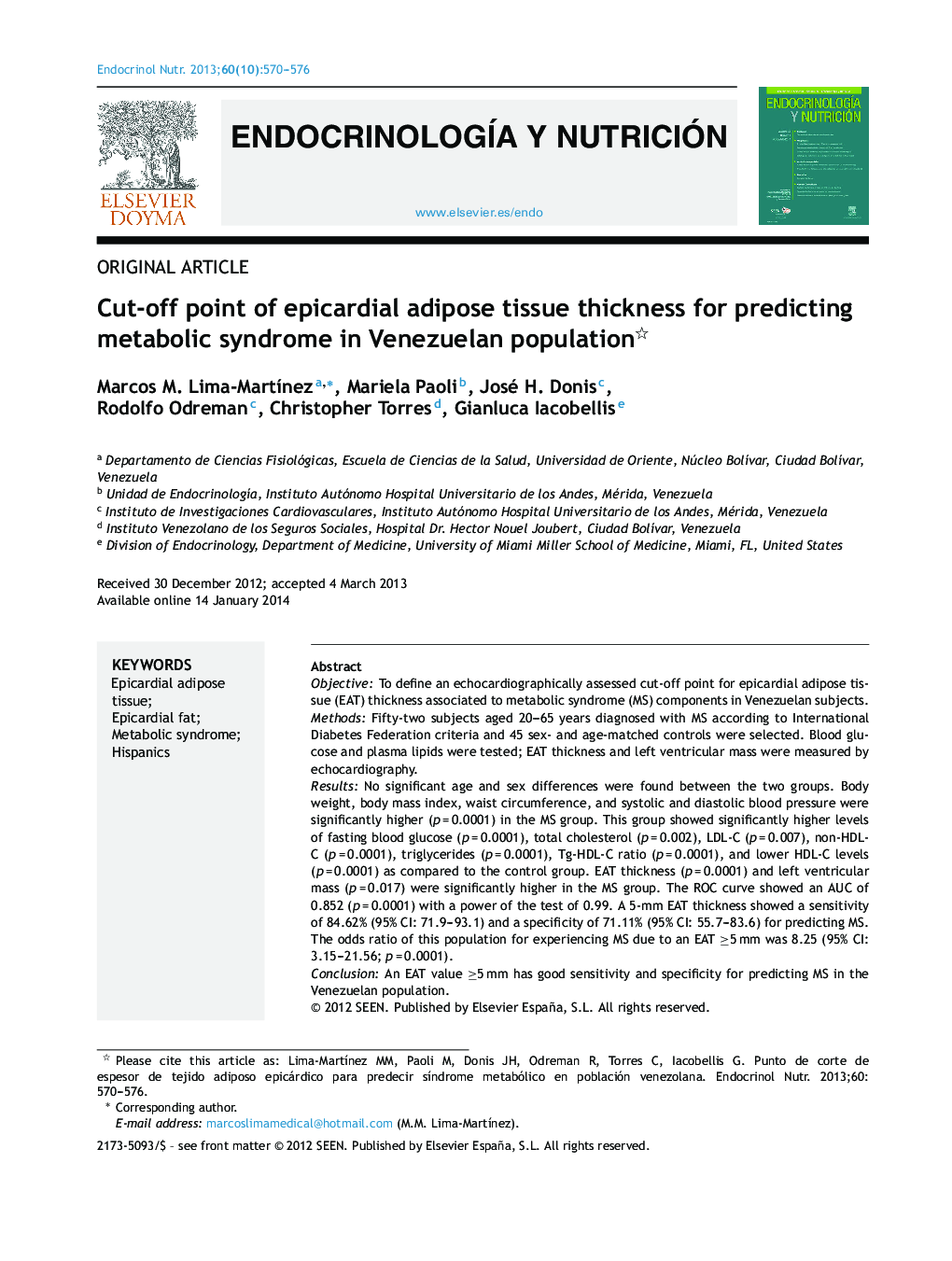| کد مقاله | کد نشریه | سال انتشار | مقاله انگلیسی | نسخه تمام متن |
|---|---|---|---|---|
| 3267095 | 1589463 | 2013 | 7 صفحه PDF | دانلود رایگان |

ObjectiveTo define an echocardiographically assessed cut-off point for epicardial adipose tissue (EAT) thickness associated to metabolic syndrome (MS) components in Venezuelan subjects.MethodsFifty-two subjects aged 20–65 years diagnosed with MS according to International Diabetes Federation criteria and 45 sex- and age-matched controls were selected. Blood glucose and plasma lipids were tested; EAT thickness and left ventricular mass were measured by echocardiography.ResultsNo significant age and sex differences were found between the two groups. Body weight, body mass index, waist circumference, and systolic and diastolic blood pressure were significantly higher (p = 0.0001) in the MS group. This group showed significantly higher levels of fasting blood glucose (p = 0.0001), total cholesterol (p = 0.002), LDL-C (p = 0.007), non-HDL-C (p = 0.0001), triglycerides (p = 0.0001), Tg-HDL-C ratio (p = 0.0001), and lower HDL-C levels (p = 0.0001) as compared to the control group. EAT thickness (p = 0.0001) and left ventricular mass (p = 0.017) were significantly higher in the MS group. The ROC curve showed an AUC of 0.852 (p = 0.0001) with a power of the test of 0.99. A 5-mm EAT thickness showed a sensitivity of 84.62% (95% CI: 71.9–93.1) and a specificity of 71.11% (95% CI: 55.7–83.6) for predicting MS. The odds ratio of this population for experiencing MS due to an EAT ≥5 mm was 8.25 (95% CI: 3.15–21.56; p = 0.0001).ConclusionAn EAT value ≥5 mm has good sensitivity and specificity for predicting MS in the Venezuelan population.
ResumenObjetivoDefinir un punto de corte de espesor de tejido adiposo epicárdico (TAE) medido por ecocardiografía asociado con los componentes del síndrome metabólico (SM) en sujetos venezolanos.MetodologíaSe seleccionaron 52 sujetos de entre 20 y 65 años con diagnóstico de SM según la Federación Internacional de Diabetes y 45 controles, comparables en edad y sexo. Se midieron glucemia y lípidos plasmáticos. Se determinaron el espesor del TAE y la masa del ventrículo izquierdo mediante ecocardiografía.ResultadosNo hubo diferencias significativas en edad y sexo entre ambos grupos, y el peso, el índice de masa corporal, la circunferencia abdominal, la presión arterial sistólica y la diastólica fueron significativamente más altos (p = 0,0001) en el grupo con SM. Este grupo presentó niveles significativamente más altos de glucemia en ayunas (p = 0,0001), colesterol total (p = 0,002), c-LDL (p = 0,007), c-noHDL (p = 0,0001), triglicéridos (p = 0,0001), cociente triglicéridos/c-HDL (p = 0,0001) y más bajos de c-HDL (p = 0,0001) que el grupo control. El espesor del TAE (p = 0,0001) y la masa del ventrículo izquierdo (p = 0,017) fueron significativamente mayores en el grupo con SM. La curva operador receptor (COR) demostró un AUC de 0,852 (p = 0,0001), con un poder del test de 0,99. El valor de 5 mm de TAE mostró una sensibilidad del 84,62% (IC 95%: 71,9–93,1) y una especificidad del 71,11% (IC 95%: 55,7–83,6) para predecir SM. La odds ratio de presentar SM en esta población por tener un espesor de TAE ≥ 5 mm fue de 8,25 (IC 95%: 3,15–21,56; p = 0,0001).ConclusiónUn valor de TAE ≥ 5 mm presenta una buena sensibilidad y especificidad para predecir SM en población venezolana.
Journal: Endocrinología y Nutrición (English Edition) - Volume 60, Issue 10, December 2013, Pages 570–576